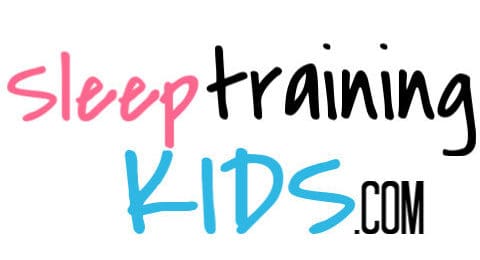As I was rocking one of my kids back to sleep during yet another sleep regression, I wondered: what’s the difference between sleep regressions and sleep disturbances?
What’s the difference between sleep regression vs sleep disturbance? Sleep regression is a word, primarily used by the public, for a negative change in a baby’s sleep. Sleep disturbances are a group of medically recognized and diagnosed disorders related to all aspects of sleep. But a deeper dive into what sleep disturbances are shows that a sleep regression could very well fit under that umbrella term.
So let’s look at what both of these important terms are – and how they relate and differ.

The Technical Differences Between Sleep Regression and Sleep Disturbance
First, let’s look at the differences between sleep regressions and sleep disturbances. Because the differences are important to note.
The exact term “sleep regression” is not found in any medical texts anywhere – online or otherwise. It wasn’t found in any of my nursing school textbooks, either. I also searched for it in the hospital library where I worked. It was nowhere to be found.
It is, however, found in the public vocabulary and the dictionary:
Sleep regression (noun) a period of time during which a baby stops sleeping as well as previously, typically one that appears to occur at a particular stage in the baby’s development.
Oxford Dictionary
So sleep regressions, while publicly recognized as a real thing, aren’t an acknowledged medical concern. Many medical professionals, myself included, know and use the word. My colleagues, when asked, were also familiar with sleep regressions.
Sleep disturbances, on the other hand, are a medical term. Here’s the definition of sleep disturbances according to the U.S. National Library of Medicine:
Sleep disturbances encompass disorders of initiating and maintaining sleep (DIMS, insomnias), disorders of excessive somnolence (DOES), disorders of sleep–wake schedule, and dysfunctions associated with sleep, sleep stages, or partial arousals (parasomnias).
NCBI, U.S National Library of Medicine
To give you a quick idea about what the different types of sleep disturbances mean, here’s a quick summary of each type in a table.
| Disorders of Initiating and Maintaining Sleep (DIMS) | Disorders of Excessive Somnolence | Disorders of Sleep-Wake Schedules | Disorders Associated with Sleep, Sleep Stages, or Partial Arousals |
|---|---|---|---|
| Disorders of Initiating and Maintaining Sleep (DIMS) | Disorders of Excessive Somnolence | Disorders of Sleep-Wake Schedules | Disorders Associated with Sleep, Sleep Stages, or Partial Arousals |
| Difficulty sleeping or Insomnias | Excessively sleepy during the day | No syncing of sleep-wake schedule and real-life work | Parasomnias, or disturbing events associated with sleep |
| Daily sleep totals of less than 75% of the expected amount | Often caused by narcolepsy or sleep apnea syndrome | A common source is “Jet lag” | The group of sleep disorders most commonly found in children |
| Disturbed sleep | Have frequent night wakings | Third or night shift workers experience “work shift” syndrome | Nightmares, sleep terrors, and night terrors |
| Associated with bipolar, anxiety, strong emotional events | “Long sleepers” simply require more sleep than average | Falling asleep at normal hours isn’t hard and sleep is restful | Patients with underlying medical conditions may be awoken by nighttime symptoms or symptom-related dreams |
| Transient (less than 3 weeks) or persistent | Society or work demands prevent regular sleep | Sleepwalking, bedwetting, and teeth-grinding |
So sleep disturbances are a huge topic in the medical field. Sleep is so important that sleep disturbances have thousands of studies done regularly. And more research will continue to be done on multiple levels, including how to help us get better sleep.
The main difference between sleep regressions and sleep disturbances is that one is a word only used by everyday people and the other is a medical term.
But let’s look at a couple of those sleep disturbance categories more closely – because sleep regressions could very easily fit into several of them.
How Sleep Regression Could Be A Sleep Disturbance
Let’s look at that table again, shall we? This time, though, let’s focus on how sleep regressions could fit into the whole umbrella of sleep disturbances.
But to make things easier, I’ll go ahead and bold the parts that are related. Because I’ve been in that exhausted, mid-sleep regression phase too often, too. And that’s a sleep disturbance for me – one that can only be managed by getting my child back to sleep already.
| Disorders of Initiating and Maintaining Sleep (DIMS) | Disorders of Excessive Somnolence | Disorders of Sleep-Wake Schedules | Disorders Associated with Sleep, Sleep Stages, or Partial Arousals |
|---|---|---|---|
| Difficulty sleeping or Insomnias | Excessively sleepy during the day | No syncing of sleep-wake schedule and real-life | Parasomnias, or disturbing events associated with sleep |
| Daily sleep totals of less than 75% of the expected amount | Often caused by narcolepsy or sleep apnea syndrome | A common source is “Jet lag” | The group of sleep disorders most commonly found in children |
| Disturbed sleep | Have frequent night wakings | Third or night shift workers experience “work shift” syndrome | Nightmares, sleep terrors, and night terrors |
| Associated with bipolar, anxiety, strong emotional events | “Long sleepers” simply require more sleep than average | Falling asleep at normal hours isn’t hard and sleep is restful | Patients with underlying medical conditions may be awoken by nighttime symptoms or symptom-related dreams |
| Transient (less than 3 weeks) or persistent | Society or work demands prevent regular sleep | Sleepwalking, bedwetting, and teeth-grinding |
Now let’s look at each of those categories in more detail.
Disorders of Initiating and Maintaining Sleep (DIMS)
Could sleep regression fit under this category? During a sleep regression:
- Babies may have a harder falling asleep.
- Children may only be getting a fraction of their usual amount of sleep.
- Kids are experiencing a disturbed sleep pattern, thanks to the frequent night wakings.
- This may also be classified as transient or persistent.
Disorders of Excessive Somnolence
Of all of the categories, this one has the least amount of overlap. Even so, during a sleep regression:
- babies experience frequent night wakings.
Sometimes, this increase in night wakings may be related to a growth spurt. So in those cases, the baby does just need to eat more before going back to sleep.
But during a sleep regression, each of my children has experienced a marked increase in nighttime wakings – and has required a lot of comforting before being able to fall back asleep.
And it’s not just me – I’ve talked to hundreds of other parents who have noticed the same scenario.
Disorders of Sleep-Wake Schedules
This group of disorders may not be the strongest fit, either. However, let’s look at the first aspect of this again.
- No sync between sleep-wake schedule and real-life work
For children, their work is playing. So from that point of view, sleep regressions do match up with this sleep disorder.
Disorders Associated with Sleep, Sleep Stages, or Partial Arousals
This group of sleep disorders is the one most commonly associated with children. Could sleep regressions become associated with this category of sleep disorders? I think so. Let’s look at how they match up.
- Babies going through developmental leaps may experience increased difficulty falling asleep
- Children experiencing a normal development of separation anxiety (at 18 months) may also experience hardship falling asleep
- Children and nightmares make for a long, difficult night (for everyone!)
So looking at sleep regressions and sleep disturbances, they could match up in several categories. That being said, will they ever become more closely related?

Will Sleep Regression Become a Medically Recognized Sleep Disturbance?
Sleep regressions and sleep disturbances probably won’t become synonyms any time soon. Sleep regression is still too new of a term. It’s also never been used or referenced in any of the medical literature.
Sleep regressions have also never been officially recognized by being given a medical definition or requirements for a diagnosis. Until that happens, they will continue to be excluded from medical terminology or studies – further preventing the term from being more widely used in the medical field.
That being said, studies are seeing a correlation between developmental milestones and sleep disruption – which does match the definition of sleep regressions.
If you’d like to see what the scientific evidence says about sleep regressions (via disruptions), make sure to read my article on it right here.
So while they aren’t exactly related yet, I think one day the medical studies may catch up to the already-accepted public vernacular – at least as related to sleep regressions, sleep disorders, and sleep disturbances.
Related Questions
What Causes Sleep Regression? Sleep regressions happen when your baby experiences a significant change that disturbs their regular sleep patterns, like a developmental leap or a time change.
How Long Does Sleep Regression Last? Sleep regressions can last anywhere from several days to six weeks or more. For more specifics on timing, read my article on how long sleep regressions last.
How Do You Know if Your Baby is Having Sleep Regression? When your baby’s sleep pattern changes significantly in quantity or quality, it might be a sleep regression.
